Ethical Issues, Data Collection, and Research Integrity in Business
VerifiedAdded on 2023/06/15
|6
|889
|358
Report
AI Summary
This report delves into the ethical questions and concerns pertinent to business research methodology, emphasizing the importance of addressing these concerns for project success. It outlines a plan for obtaining consent for data collection, identifies potential causes of harm involved in research projects, and proposes methods for overcoming these harms. The report also details the process of ensuring confidentiality and anonymity in data collection and addresses instances where sufficient data could not be collected. Key areas covered include managing controversial subject matter, addressing participant literacy levels, handling potential conflicts of interest, and securing personal data to uphold ethical standards and ensure the reliability and credibility of research outcomes. This document is available on Desklib, a platform offering a wide array of study tools and solved assignments for students.

Running head: BUSINESS RESEARCH METHODOLOGY
Business Research Methodology
Name of the Student:
Name of the University:
Author Note:
Business Research Methodology
Name of the Student:
Name of the University:
Author Note:
Paraphrase This Document
Need a fresh take? Get an instant paraphrase of this document with our AI Paraphraser
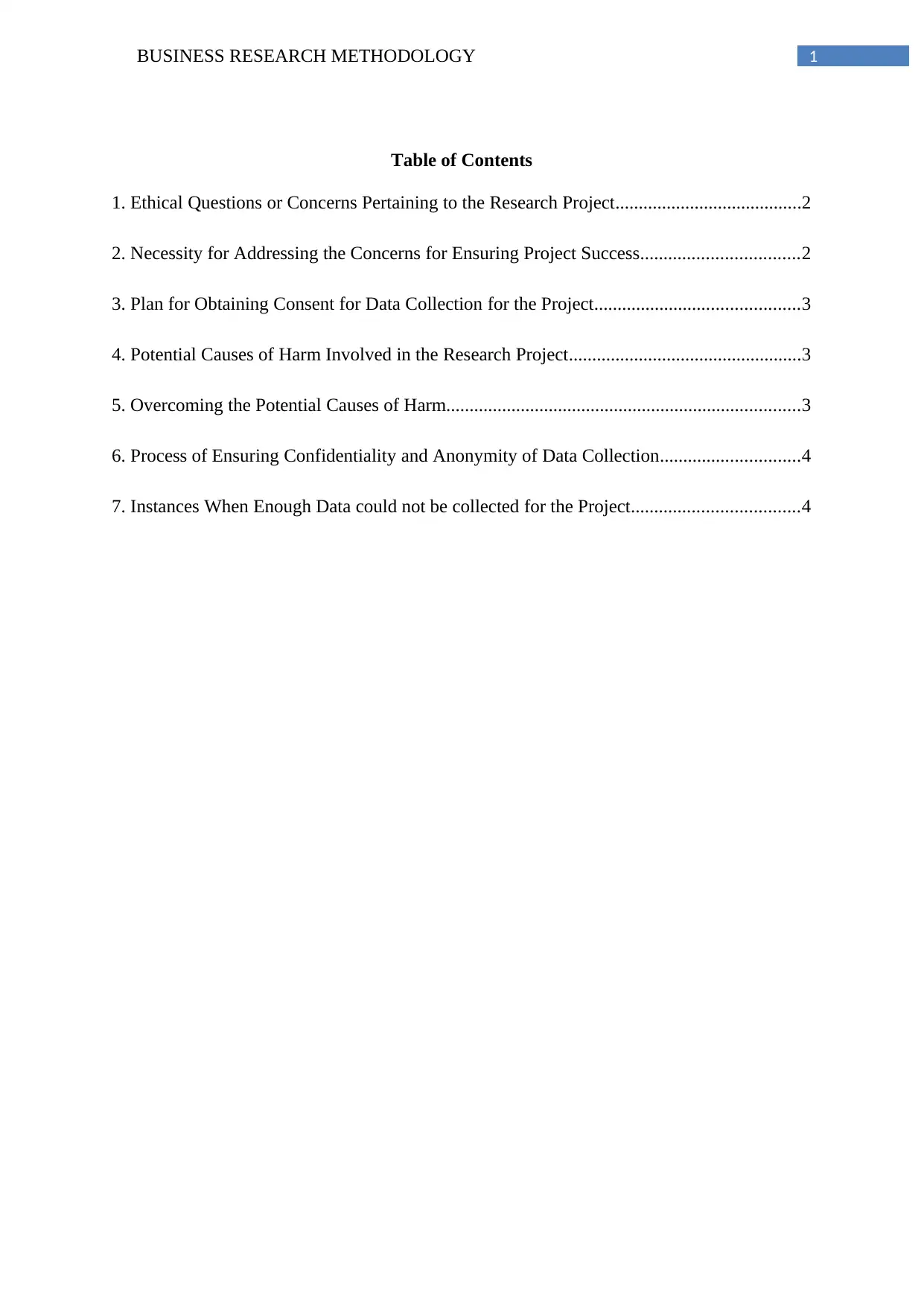
1BUSINESS RESEARCH METHODOLOGY
Table of Contents
1. Ethical Questions or Concerns Pertaining to the Research Project........................................2
2. Necessity for Addressing the Concerns for Ensuring Project Success..................................2
3. Plan for Obtaining Consent for Data Collection for the Project............................................3
4. Potential Causes of Harm Involved in the Research Project..................................................3
5. Overcoming the Potential Causes of Harm............................................................................3
6. Process of Ensuring Confidentiality and Anonymity of Data Collection..............................4
7. Instances When Enough Data could not be collected for the Project....................................4
Table of Contents
1. Ethical Questions or Concerns Pertaining to the Research Project........................................2
2. Necessity for Addressing the Concerns for Ensuring Project Success..................................2
3. Plan for Obtaining Consent for Data Collection for the Project............................................3
4. Potential Causes of Harm Involved in the Research Project..................................................3
5. Overcoming the Potential Causes of Harm............................................................................3
6. Process of Ensuring Confidentiality and Anonymity of Data Collection..............................4
7. Instances When Enough Data could not be collected for the Project....................................4
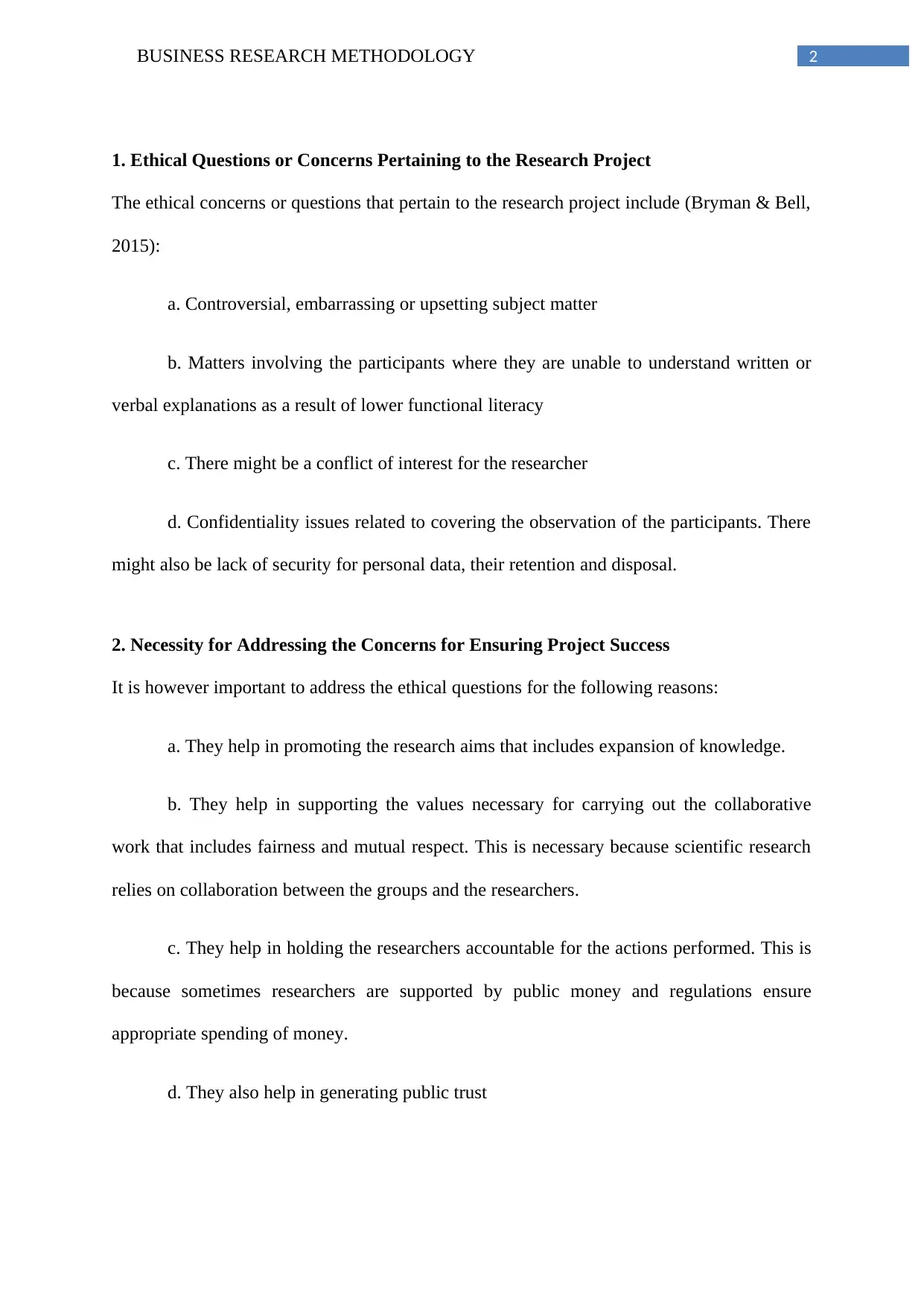
2BUSINESS RESEARCH METHODOLOGY
1. Ethical Questions or Concerns Pertaining to the Research Project
The ethical concerns or questions that pertain to the research project include (Bryman & Bell,
2015):
a. Controversial, embarrassing or upsetting subject matter
b. Matters involving the participants where they are unable to understand written or
verbal explanations as a result of lower functional literacy
c. There might be a conflict of interest for the researcher
d. Confidentiality issues related to covering the observation of the participants. There
might also be lack of security for personal data, their retention and disposal.
2. Necessity for Addressing the Concerns for Ensuring Project Success
It is however important to address the ethical questions for the following reasons:
a. They help in promoting the research aims that includes expansion of knowledge.
b. They help in supporting the values necessary for carrying out the collaborative
work that includes fairness and mutual respect. This is necessary because scientific research
relies on collaboration between the groups and the researchers.
c. They help in holding the researchers accountable for the actions performed. This is
because sometimes researchers are supported by public money and regulations ensure
appropriate spending of money.
d. They also help in generating public trust
1. Ethical Questions or Concerns Pertaining to the Research Project
The ethical concerns or questions that pertain to the research project include (Bryman & Bell,
2015):
a. Controversial, embarrassing or upsetting subject matter
b. Matters involving the participants where they are unable to understand written or
verbal explanations as a result of lower functional literacy
c. There might be a conflict of interest for the researcher
d. Confidentiality issues related to covering the observation of the participants. There
might also be lack of security for personal data, their retention and disposal.
2. Necessity for Addressing the Concerns for Ensuring Project Success
It is however important to address the ethical questions for the following reasons:
a. They help in promoting the research aims that includes expansion of knowledge.
b. They help in supporting the values necessary for carrying out the collaborative
work that includes fairness and mutual respect. This is necessary because scientific research
relies on collaboration between the groups and the researchers.
c. They help in holding the researchers accountable for the actions performed. This is
because sometimes researchers are supported by public money and regulations ensure
appropriate spending of money.
d. They also help in generating public trust
⊘ This is a preview!⊘
Do you want full access?
Subscribe today to unlock all pages.

Trusted by 1+ million students worldwide
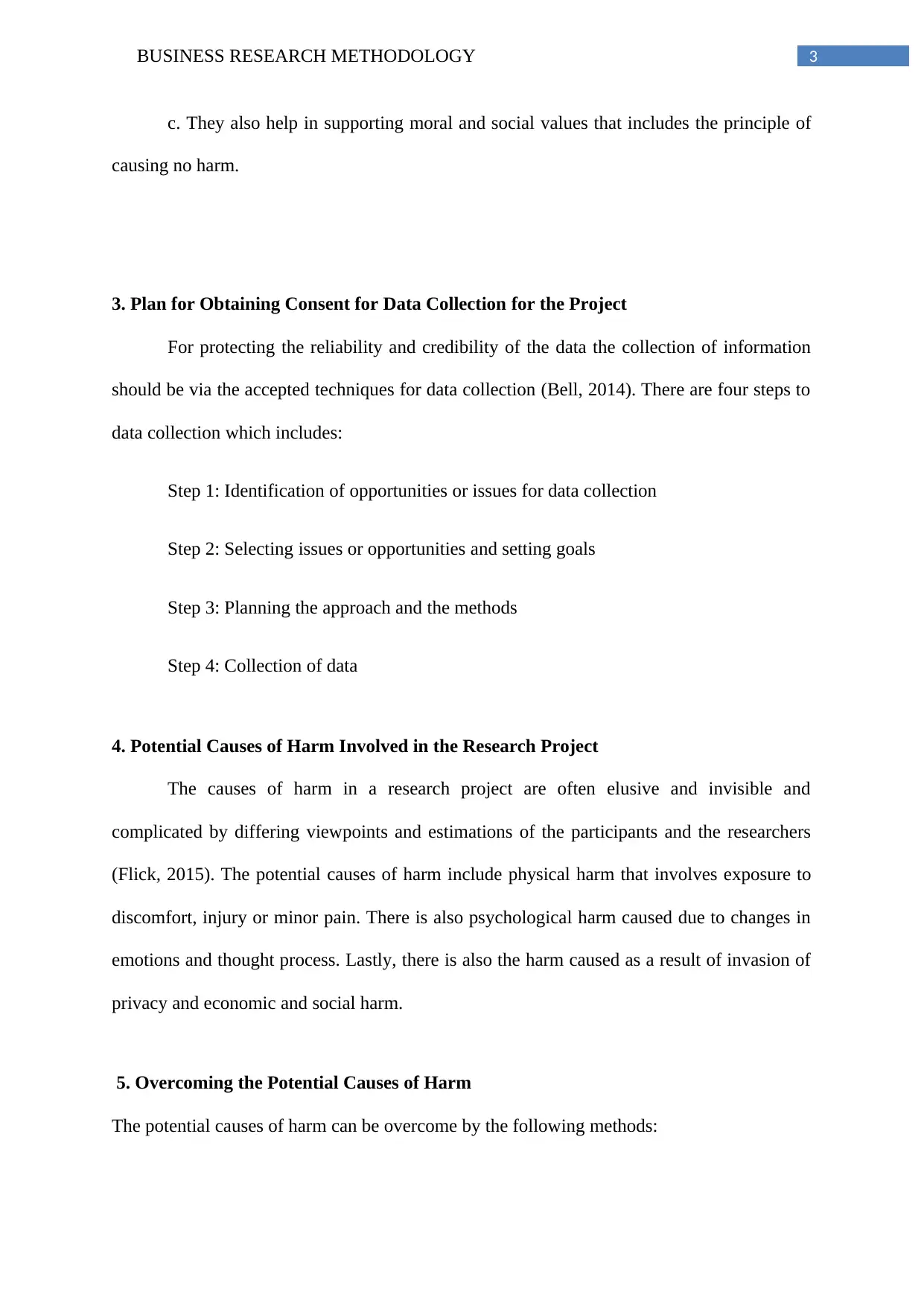
3BUSINESS RESEARCH METHODOLOGY
c. They also help in supporting moral and social values that includes the principle of
causing no harm.
3. Plan for Obtaining Consent for Data Collection for the Project
For protecting the reliability and credibility of the data the collection of information
should be via the accepted techniques for data collection (Bell, 2014). There are four steps to
data collection which includes:
Step 1: Identification of opportunities or issues for data collection
Step 2: Selecting issues or opportunities and setting goals
Step 3: Planning the approach and the methods
Step 4: Collection of data
4. Potential Causes of Harm Involved in the Research Project
The causes of harm in a research project are often elusive and invisible and
complicated by differing viewpoints and estimations of the participants and the researchers
(Flick, 2015). The potential causes of harm include physical harm that involves exposure to
discomfort, injury or minor pain. There is also psychological harm caused due to changes in
emotions and thought process. Lastly, there is also the harm caused as a result of invasion of
privacy and economic and social harm.
5. Overcoming the Potential Causes of Harm
The potential causes of harm can be overcome by the following methods:
c. They also help in supporting moral and social values that includes the principle of
causing no harm.
3. Plan for Obtaining Consent for Data Collection for the Project
For protecting the reliability and credibility of the data the collection of information
should be via the accepted techniques for data collection (Bell, 2014). There are four steps to
data collection which includes:
Step 1: Identification of opportunities or issues for data collection
Step 2: Selecting issues or opportunities and setting goals
Step 3: Planning the approach and the methods
Step 4: Collection of data
4. Potential Causes of Harm Involved in the Research Project
The causes of harm in a research project are often elusive and invisible and
complicated by differing viewpoints and estimations of the participants and the researchers
(Flick, 2015). The potential causes of harm include physical harm that involves exposure to
discomfort, injury or minor pain. There is also psychological harm caused due to changes in
emotions and thought process. Lastly, there is also the harm caused as a result of invasion of
privacy and economic and social harm.
5. Overcoming the Potential Causes of Harm
The potential causes of harm can be overcome by the following methods:
Paraphrase This Document
Need a fresh take? Get an instant paraphrase of this document with our AI Paraphraser
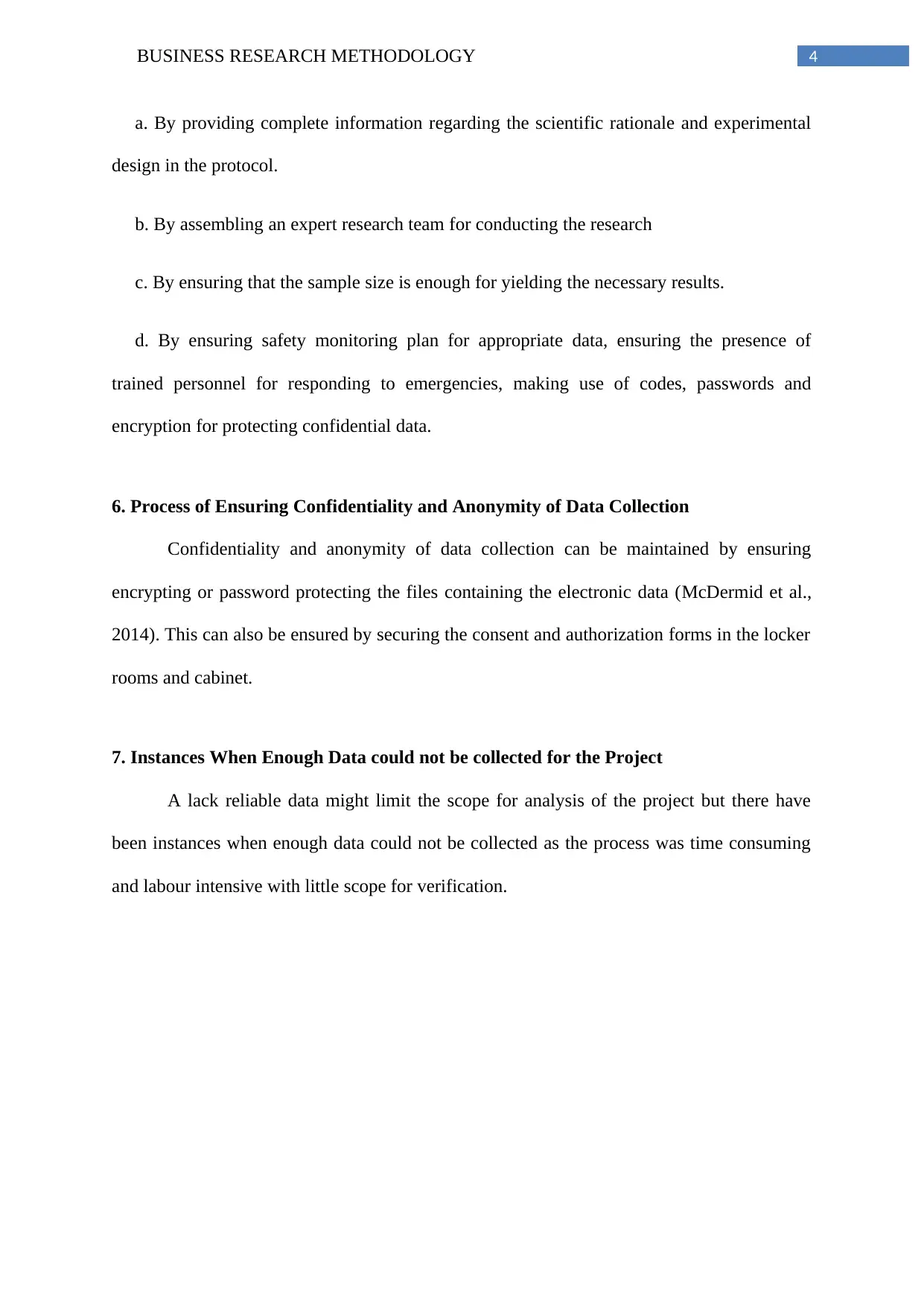
4BUSINESS RESEARCH METHODOLOGY
a. By providing complete information regarding the scientific rationale and experimental
design in the protocol.
b. By assembling an expert research team for conducting the research
c. By ensuring that the sample size is enough for yielding the necessary results.
d. By ensuring safety monitoring plan for appropriate data, ensuring the presence of
trained personnel for responding to emergencies, making use of codes, passwords and
encryption for protecting confidential data.
6. Process of Ensuring Confidentiality and Anonymity of Data Collection
Confidentiality and anonymity of data collection can be maintained by ensuring
encrypting or password protecting the files containing the electronic data (McDermid et al.,
2014). This can also be ensured by securing the consent and authorization forms in the locker
rooms and cabinet.
7. Instances When Enough Data could not be collected for the Project
A lack reliable data might limit the scope for analysis of the project but there have
been instances when enough data could not be collected as the process was time consuming
and labour intensive with little scope for verification.
a. By providing complete information regarding the scientific rationale and experimental
design in the protocol.
b. By assembling an expert research team for conducting the research
c. By ensuring that the sample size is enough for yielding the necessary results.
d. By ensuring safety monitoring plan for appropriate data, ensuring the presence of
trained personnel for responding to emergencies, making use of codes, passwords and
encryption for protecting confidential data.
6. Process of Ensuring Confidentiality and Anonymity of Data Collection
Confidentiality and anonymity of data collection can be maintained by ensuring
encrypting or password protecting the files containing the electronic data (McDermid et al.,
2014). This can also be ensured by securing the consent and authorization forms in the locker
rooms and cabinet.
7. Instances When Enough Data could not be collected for the Project
A lack reliable data might limit the scope for analysis of the project but there have
been instances when enough data could not be collected as the process was time consuming
and labour intensive with little scope for verification.
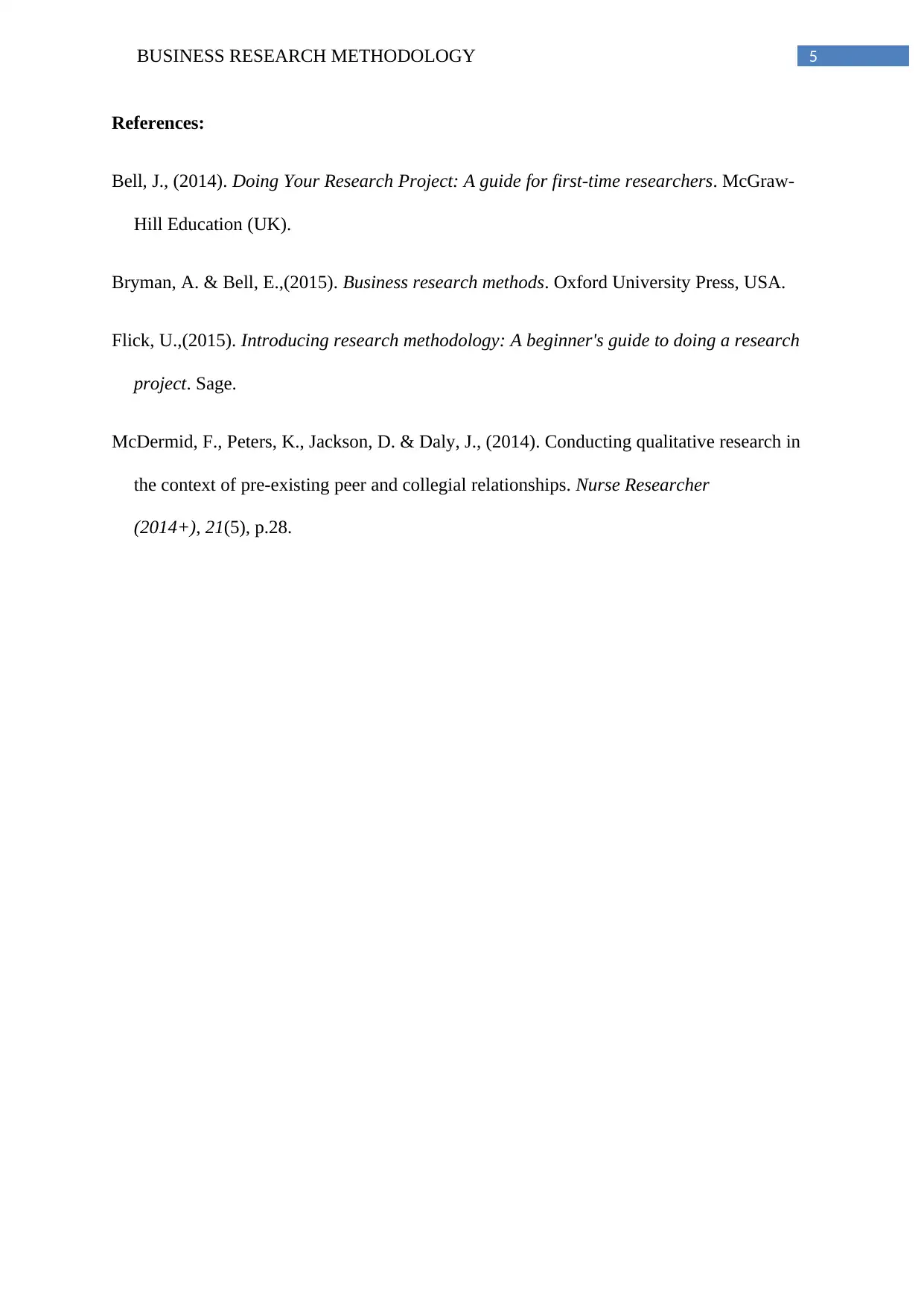
5BUSINESS RESEARCH METHODOLOGY
References:
Bell, J., (2014). Doing Your Research Project: A guide for first-time researchers. McGraw-
Hill Education (UK).
Bryman, A. & Bell, E.,(2015). Business research methods. Oxford University Press, USA.
Flick, U.,(2015). Introducing research methodology: A beginner's guide to doing a research
project. Sage.
McDermid, F., Peters, K., Jackson, D. & Daly, J., (2014). Conducting qualitative research in
the context of pre-existing peer and collegial relationships. Nurse Researcher
(2014+), 21(5), p.28.
References:
Bell, J., (2014). Doing Your Research Project: A guide for first-time researchers. McGraw-
Hill Education (UK).
Bryman, A. & Bell, E.,(2015). Business research methods. Oxford University Press, USA.
Flick, U.,(2015). Introducing research methodology: A beginner's guide to doing a research
project. Sage.
McDermid, F., Peters, K., Jackson, D. & Daly, J., (2014). Conducting qualitative research in
the context of pre-existing peer and collegial relationships. Nurse Researcher
(2014+), 21(5), p.28.
⊘ This is a preview!⊘
Do you want full access?
Subscribe today to unlock all pages.

Trusted by 1+ million students worldwide
1 out of 6
Related Documents
Your All-in-One AI-Powered Toolkit for Academic Success.
+13062052269
info@desklib.com
Available 24*7 on WhatsApp / Email
![[object Object]](/_next/static/media/star-bottom.7253800d.svg)
Unlock your academic potential
Copyright © 2020–2025 A2Z Services. All Rights Reserved. Developed and managed by ZUCOL.





